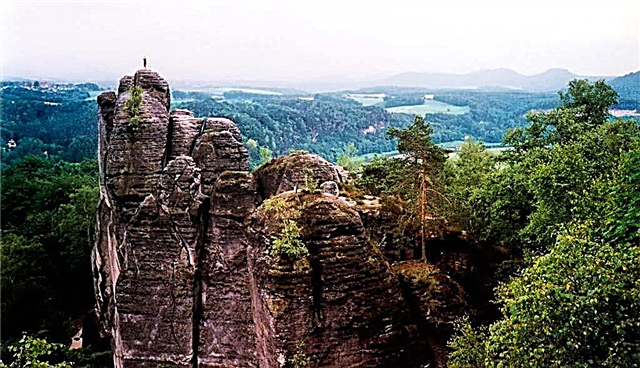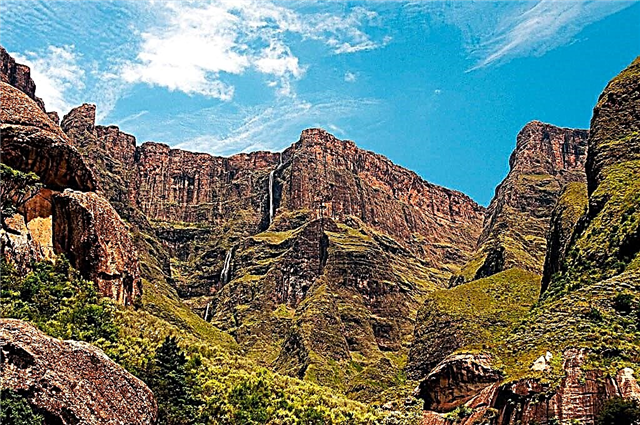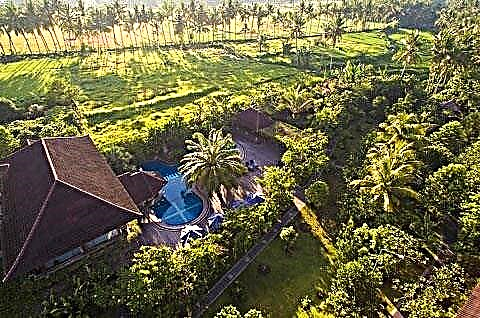Between the two small classic German cities of Rathen and Velen, where both indigenous people and tourists come to rest, there is a large rocky massif Bastei, towering over the seething Elbe to a height of almost two hundred meters. High cliffs are striking in their inaccessibility, and once they were considered as such. But today, modern technology has turned them into an ideal observation deck, climbing on which, you can look around the entire region, called Saxon Switzerland by some visiting artists.

History
In the thirteenth century, the locals used Bastei as a defensive system, for which a castle-fortress was built. Looking at Bastei, it is easy to imagine how sentries marched along the most gentle cliffs, looking out for enemies from foreign sides, how they guarded the peaceful sleep of German citizens day and night.

So the fortress stood for almost three hundred years. One sentinel was replaced by another, and the country could sleep peacefully. However, in the 16th century, it was decided to leave the stone bastion. No serious attacks were foreseen from this side, and experience showed that the rocks, even without sentries, do an excellent job of their function. So, at the beginning of the sixteenth century, the military left the Bastei fortress. Forgotten and abandoned, the structure gradually began to collapse. And only in the twentieth century began its restoration work.

Tourism development
Tourists began to take an interest in the stone bastion in Saxony at the beginning of the nineteenth century. They gathered in small groups to enjoy the beauty of the high cliffs. Noticing albeit a small influx of tourists, local residents began to open the first retail stores.

Conversations about Bastai gradually reached the ears of artists, who, armed with easels and paints, went to paint the incredibly beautiful rocks. This is how the "trail of artists" gradually took shape. The rocks also did not pass by the canvases of Caspar David Friedrich, who often walked along Bastai, looking for inspiration. He depicted the local landscape on several canvases, in addition to this, the stone bastion became the setting for several of his works in the future.

Suspension bridge
One of the main attractions of Bastei was the suspension bridge, which was thrown over a deep gorge. It was made in 1824. It was made of wood, but the evil winds blowing on Bastei, and endless rains with snow did their job: wooden boards had to be replaced almost every year, and after thirty years of torment, it was decided to replace the wood with sandstone. This is how the famous Bastei Bridge was erected, which today is included in the list of architectural and historical monuments in Germany.

However, many tourists visited Bastei even before the construction of the bridge. They climbed steep cliffs, climbed steep slopes, traveled long distances - all in order to enjoy the view from the height of the stone bastion.
The construction of the bridge greatly facilitated the way for tourists to the old fortress. Walking over a gorge with a depth of almost 200 meters along a stone bridge is an incredible feeling and feeling of flight. And the picturesque views from the observation platforms will make even a stone heart tremble.
Fields and forests of incredible beauty, stretching near the stone bastion, enchant with their freshness and virgin integrity. In sunny weather, nature paints the world around with bright colors, and in rainy and foggy weather, it allows travelers to feel like running through the clouds.

Saxon Switzerland
Bastei is located in the parkland of Saxon Switzerland. Why is the German region named after another country? The explanation is very romantic. At the end of the eighteenth century, the Academy of Arts existed in Dresden, where artists from all over Europe came to study and teach. Longing away from home, young students often walked around the area, studying landscapes.
So, a couple of Swiss students once went to Bastai, and the high cliffs reminded them of a house. Now, when young people wrote letters home, they invariably called this place Saxon Switzerland. A few years later, these letters came to Wilhelm Lebrecht Goetzinger, a popular German writer. The new name of the area so touched and surprised him that he began to use it in his own works. So, gradually, the name changed.

Bastei is the greatest natural structure, which is the main feature of Saxon Switzerland and today it is one of the most visited places in the world. Both tourists and locals come to see it. It is especially popular among rock climbers who climb the peaks of Bastei in small groups.

How to get there on your own
Most visitors today stop in Dresden and later hire a boat. By water, they easily reached Bastai Rathen, a small but very cozy town spread in the shadows. Having reached Rathen, the only thing left is to climb the rocks.
[tp_calendar_widget origin = MOW destination = DRS responsive = true subid = ”bastaj”]
Previously, travelers and the military had to look for all sorts of ways to climb the stone bastion. But in 1814, for greater comfort, a staircase consisting of 487 steps was punched into the slopes. It leads to the top directly from the bottom of the valley. Of course, the stairs are pretty steep, so you need to climb carefully. However, this is still many times better and more convenient than wading through the thickets and crawling up the cliff.

Many rocks that make up Bastai resemble the outlines of animals, people, and figures. One of them was especially highlighted by climbers. It resembles two hands folded in supplication, for which it got its name - Monk. Once a group of climbers climbed onto it and placed their banner, which still flutters on a high pillar. They don't even try to take it off - no one knows exactly how to get on the Monk.
Bastei on the map
Bastei is a beautiful place, visiting which you will experience a range of emotions, but not disappointment. Rural well-kept houses, fields, dense forests - all this could be a landscape from a fairy tale, but it came true in Saxon Switzerland.
Another interesting place is Burg Eltz Castle in Germany.











